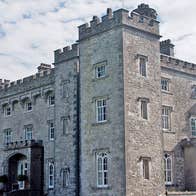Duleek derives from the Irish damhliag, meaning ‘stone house or church’ and refers to the 5th Century construction, possibly the first stone building in Ireland.
Care of the bishopric was granted to one of St Patrick’s followers, St Cianan. The ruins of his church can be seen opposite those of the priory. During the 9th and 10th Centuries, the monastery suffered near constant raids by Vikings settled at nearby Drogheda. Incredibly, the small community survived. In 1014, the Vikings were defeated by the Irish High King, Brian Boru, at The Battle of Clontarf. Boru was slain, his body lay in Duleek Abbey before being brought to Armagh for burial.
The impressive ruins are the remains of an Augustinian priory, St Mary’s Abbey, established in the 12th Century. Outside, a beautiful, 9th Century high cross bears elaborate carvings typical of the period, the crucifixion, scenes from the life of the Virgin Mary, symbols of the evangelists.
Did you know? During the 19th Century, Duleek Commons was a hideout for 'Collier the Robber', a Robin Hood style highway man eventually transported to the penal colonies. King William is said to have slept in Duleek Abbey after the Battle of the Boyne. A heritage trail of the town begins at the courthouse in Duleek.






